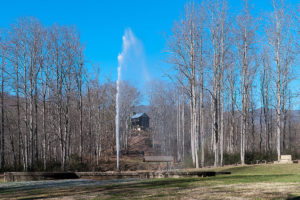Just a few hundred feet beyond where the man-made fountain, known as Andrews Geyser, shoots water 80 feet into the air lies the historic Round Knob Lodge. Built in the 1930s by Southern Railroad executives as a rustic mountain retreat, the 6500-square-foot lodge replaced the ritzy Round Knob Hotel, which served railroad passengers and employees from the 1880s until it burned in 1903.
In 2016, the lodge will be the backdrop for the incredible story of North Carolina’s quest to lay track up the steep grade from Old Fort to Asheville during the Swannanoa Valley Museum & History Center’s 5th Annual Historic Haunted House Tours on Friday, October 28 and Saturday, October 29.
Costumed tour guides will escort guests to the lodge from one lavishly decorated room to another where they will eavesdrop on costumed actors reenacting historic scenes from before, during, and after the coming of the railroad.
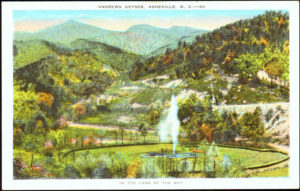 Before the railroad carved its steel path to the crest of the Blue Ridge, the mountains had to be conquered on foot trails, by horse and wagon over rough roads, or on mule or horseback. Tourists still flocked to the region from the southeastern Charleston area, seeking a respite from sweltering temperatures, biting insects, and tuberculosis – but the mountainous barrier often deterred visitors from eastern North Carolina from making the trek. The tour’s first stop will feature a few early travelers plotting their trip up the mountains on a tourist excursion.
Before the railroad carved its steel path to the crest of the Blue Ridge, the mountains had to be conquered on foot trails, by horse and wagon over rough roads, or on mule or horseback. Tourists still flocked to the region from the southeastern Charleston area, seeking a respite from sweltering temperatures, biting insects, and tuberculosis – but the mountainous barrier often deterred visitors from eastern North Carolina from making the trek. The tour’s first stop will feature a few early travelers plotting their trip up the mountains on a tourist excursion.
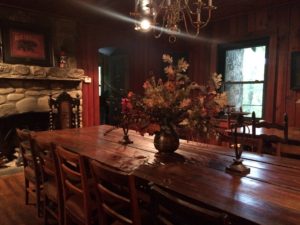 In 1855, the North Carolina legislature issued a charter to the Western North Carolina Railroad to begin laying track from Salisbury to “beyond the Blue Ridge.” The outbreak of the Civil War delayed construction and it wasn’t until 1869 that track was laid into Old Fort. The steep grade and corruption among those granted money to complete the line delayed the continuation of track into Asheville. Finally, in 1875 in an effort to cut costs, the railroad corporation began leasing convicts – who were primarily African-Americans imprisoned for petty crimes – to perform the brutal work required to cut embankments, culverts, arches, and tunnels into the mountain. Because the railroad could simply lease another convict if one died while working there was little incentive to keep the men healthy and during the course of construction 125 workers died in tunnel cave-ins and other accidents.
In 1855, the North Carolina legislature issued a charter to the Western North Carolina Railroad to begin laying track from Salisbury to “beyond the Blue Ridge.” The outbreak of the Civil War delayed construction and it wasn’t until 1869 that track was laid into Old Fort. The steep grade and corruption among those granted money to complete the line delayed the continuation of track into Asheville. Finally, in 1875 in an effort to cut costs, the railroad corporation began leasing convicts – who were primarily African-Americans imprisoned for petty crimes – to perform the brutal work required to cut embankments, culverts, arches, and tunnels into the mountain. Because the railroad could simply lease another convict if one died while working there was little incentive to keep the men healthy and during the course of construction 125 workers died in tunnel cave-ins and other accidents.
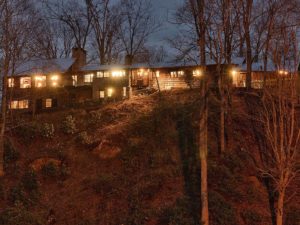 As one set of workers toiled to bring the Old Fort end of the track up the mountain another set of workers constructed track down the mountain, ultimately meeting perfectly in the middle of the longest of the seven tunnels and, allowing the chief engineer of the project, James H. Wilson, to send a telegram to NC Governor Zebulon B. Vance on March 11, 1879 stating that “daylight entered Buncombe County this morning through the Swannanoa Tunnel.” The tunnel was partly cut with the use of nitroglycerine – one of the earliest uses of the explosive in engineering.
As one set of workers toiled to bring the Old Fort end of the track up the mountain another set of workers constructed track down the mountain, ultimately meeting perfectly in the middle of the longest of the seven tunnels and, allowing the chief engineer of the project, James H. Wilson, to send a telegram to NC Governor Zebulon B. Vance on March 11, 1879 stating that “daylight entered Buncombe County this morning through the Swannanoa Tunnel.” The tunnel was partly cut with the use of nitroglycerine – one of the earliest uses of the explosive in engineering.
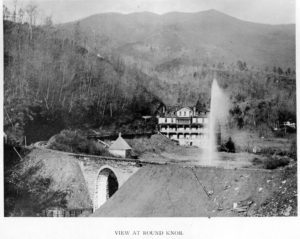 Once the railroad finally began running service to and from Asheville to the eastern portion of North Carolina, tourism to the area boomed and businesses sprang up surround train depots to cater to the many tourists flocking to the area. As part of the effort to attract and accommodate tourists, private investors built the 5-story Round Knob Hotel within one of many secluded coves looped by the railroad track. Above the lodge they dammed a large pond and piped water down the mountain to feed the man-made Andrews Geyser, built as a tourist attraction and memorial to those who died constructing the railroad. The geyser could be seen by railroad passengers seven times as the cars looped around the tracks. Visitors to the lodge can view the geyser from a unique vantage point on the Lodge’s screened-in porch situated on the mountainside above.
Once the railroad finally began running service to and from Asheville to the eastern portion of North Carolina, tourism to the area boomed and businesses sprang up surround train depots to cater to the many tourists flocking to the area. As part of the effort to attract and accommodate tourists, private investors built the 5-story Round Knob Hotel within one of many secluded coves looped by the railroad track. Above the lodge they dammed a large pond and piped water down the mountain to feed the man-made Andrews Geyser, built as a tourist attraction and memorial to those who died constructing the railroad. The geyser could be seen by railroad passengers seven times as the cars looped around the tracks. Visitors to the lodge can view the geyser from a unique vantage point on the Lodge’s screened-in porch situated on the mountainside above.
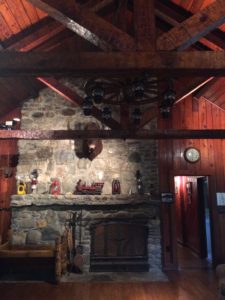 Antique railroad items adorn the walls, ledges, and mantles throughout the lodge perfectly complimenting the lavish seasonal decorations used to set the stage for dramatic retellings of some of the spookier aspects of area railroading and tourism history. As guests make their way from room to room they’ll enjoy roaring fires, roving spirits, and floating orbs surrounded by original Pullman sleeper car benches, antique lanterns, and vintage telephone boxes.
Antique railroad items adorn the walls, ledges, and mantles throughout the lodge perfectly complimenting the lavish seasonal decorations used to set the stage for dramatic retellings of some of the spookier aspects of area railroading and tourism history. As guests make their way from room to room they’ll enjoy roaring fires, roving spirits, and floating orbs surrounded by original Pullman sleeper car benches, antique lanterns, and vintage telephone boxes.
The tour of the lodge will continue down an antique cast-iron spiral staircase – or interior elevator – into the rock-walled basement below for refreshments (included in tour price) served by a ghostly bartender where guests can relax and imagine what it would have been like to be a railroad executive vacationing at the lodge in the 1930s. Guests will then journey down a narrow passageway to tour more several more historic vignettes before venturing down the “haunted hallway” where several of the lodge’s past guests have photographed ghostly orbs, often thought to be the souls of people.
More historic than haunted, the Museum’s Historic Haunted House Tours are lively, entertaining, and educational. Tours last approximately two hours and begin every half hour with the first tour at 5:30pm and the last tour leaving at 8:00pm on both Friday, October 28 and Saturday, October 29. Pre-registration is required and can be done through the Museum’s website at www.swannanoavalleymuseum.org/october, by phone 828-669-9566, or in person until the beginning of each tour or until each tour is sold out. Please arrive at least 15 minutes before your tour is scheduled to depart.
